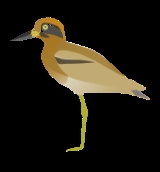
Great Thick-knee
Encyclopedia
The Great Stone-curlew or Great Thick-knee (Esacus recurvirostris) is a large wader
which is a resident breeder in tropical southern Asia
from India
, Pakistan
, Sri Lanka
into South-east Asia.
This species prefers gravel banks along rivers or large lakes, and also beaches. A single egg is laid in a bare scrape on the open shingle.
It is mainly nocturnal or crepuscular
like other stone-curlew
s, but can frequently be seen foraging during the day, moving slowly and deliberately, with occasional short runs. It tends to be wary and flies off into the distance ahead of the observer, employing powerful, rather stiff wingbeats.
The Great Thick-knee is a large wader at 49–55 cm, and has a massive 7 cm upturned bill. It has unstreaked grey-brown upperparts and breast, with rest of the underparts whitish. The face has a striking black and white pattern, and the bill is black with a yellow base. The eyes are bright yellow and the legs a duller greenish-yellow.
In flight, the Great Thick-knee shows black and white flight feathers on the upperwing, and a mainly white underwing. Sexes are similar, but young birds are slightly paler than adults.
The call is a wailing whistle, given mainly at night, as with other birds in this family. The Great Thick-knee eats crabs, large insects, and other animal prey.
Wader
Waders, called shorebirds in North America , are members of the order Charadriiformes, excluding the more marine web-footed seabird groups. The latter are the skuas , gulls , terns , skimmers , and auks...
which is a resident breeder in tropical southern Asia
Asia
Asia is the world's largest and most populous continent, located primarily in the eastern and northern hemispheres. It covers 8.7% of the Earth's total surface area and with approximately 3.879 billion people, it hosts 60% of the world's current human population...
from India
India
India , officially the Republic of India , is a country in South Asia. It is the seventh-largest country by geographical area, the second-most populous country with over 1.2 billion people, and the most populous democracy in the world...
, Pakistan
Pakistan
Pakistan , officially the Islamic Republic of Pakistan is a sovereign state in South Asia. It has a coastline along the Arabian Sea and the Gulf of Oman in the south and is bordered by Afghanistan and Iran in the west, India in the east and China in the far northeast. In the north, Tajikistan...
, Sri Lanka
Sri Lanka
Sri Lanka, officially the Democratic Socialist Republic of Sri Lanka is a country off the southern coast of the Indian subcontinent. Known until 1972 as Ceylon , Sri Lanka is an island surrounded by the Indian Ocean, the Gulf of Mannar and the Palk Strait, and lies in the vicinity of India and the...
into South-east Asia.
This species prefers gravel banks along rivers or large lakes, and also beaches. A single egg is laid in a bare scrape on the open shingle.
It is mainly nocturnal or crepuscular
Crepuscular
Crepuscular animals are those that are active primarily during twilight, that is during dawn and dusk. The word is derived from the Latin word crepusculum, meaning "twilight." Crepuscular is, thus, in contrast with diurnal and nocturnal behavior. Crepuscular animals may also be active on a bright...
like other stone-curlew
Stone-curlew
The Stone-curlews, also known as Dikkops or Thick-knees are a group of largely tropical birds in the family Burhinidae. Despite the group being classified as waders, most species have a preference for arid or semi-arid habitats...
s, but can frequently be seen foraging during the day, moving slowly and deliberately, with occasional short runs. It tends to be wary and flies off into the distance ahead of the observer, employing powerful, rather stiff wingbeats.
The Great Thick-knee is a large wader at 49–55 cm, and has a massive 7 cm upturned bill. It has unstreaked grey-brown upperparts and breast, with rest of the underparts whitish. The face has a striking black and white pattern, and the bill is black with a yellow base. The eyes are bright yellow and the legs a duller greenish-yellow.
In flight, the Great Thick-knee shows black and white flight feathers on the upperwing, and a mainly white underwing. Sexes are similar, but young birds are slightly paler than adults.
The call is a wailing whistle, given mainly at night, as with other birds in this family. The Great Thick-knee eats crabs, large insects, and other animal prey.

